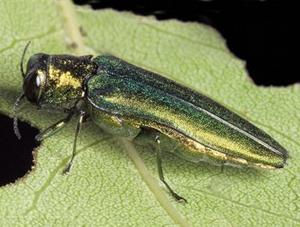Food safetyFocus on terrorism allowed foreign pests to slip into U.S.
Following the 9/11 attacks the U.S. government assigned hundreds of agricultural scientists responsible for stopping invasive species at the border to anti-terrorism duties; the result has been that dozens of foreign insects and plant diseases managed to slip undetected into the United States

The emerald ash borer, invader from China // Source: tn.gov
Following the 9/11 attacks the U.S. government assigned hundreds of agricultural scientists responsible for stopping invasive species at the border to anti-terrorism duties. The result has been that dozens of foreign insects and plant diseases managed to slip undetected into the United States
Experts now say that the problem has reached the point where the quality of the U.S. food supply is under threat.
The economic damage is not in dispute: scientists say that the foreign pest explosion cost billions of dollars in crop damage and eradication efforts from California vineyards to Florida citrus groves.
The New York Daily News offers these highlights:
— Nineteen Mediterranean fruit fly infestations took hold in California, and the European grapevine moth triggered spraying and quarantines in California’s wine country.
— The Asian citrus psyllid, which can carry a disease that has decimated Florida orange groves, crossed the border from Mexico, threatening California’s $1.8 billion citrus industry.
— New Zealand’s light brown apple moth was detected in California, prompting the government in 2008 to bombard the Monterey Bay area with 1,600 pounds of pesticides. The spraying caused respiratory problems and killed birds. Officials spent $110 million to eradicate the moth, but the effort failed.
— The sweet orange scab, a fungal disease that infects citrus, appeared in Florida, Texas, Louisiana, and Mississippi, leading the states to impose quarantines.
— Chili thrips, rice cutworms and the plant disease gladiolus rust also got into Florida, which experienced a 27 percent increase in new pests and pathogens between 2003 and 2007.
— The erythrina gall wasp decimated Hawaii’s wiliwili trees, which bear seeds used to make leis.
— Forests from Minnesota to Washington state were also affected by beetles such as the emerald ash borer, many of which arrived in Chinese shipping pallets.
The Daily News says that the number of pest cases intercepted at U.S. ports of entry fell from more than 81,200 in 2002 to fewer than 58,500 in 2006, before climbing back up in 2007, after complaints from the farm industry.
